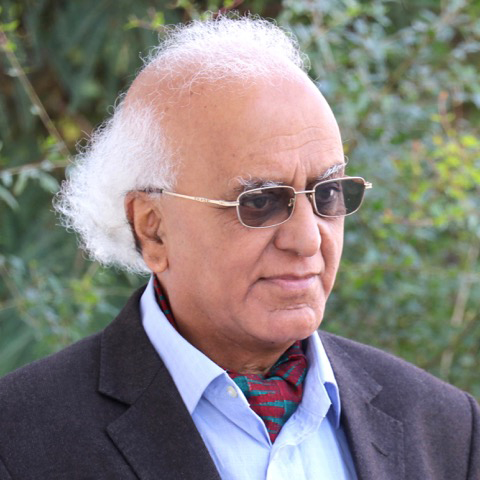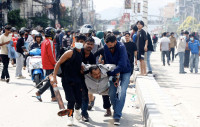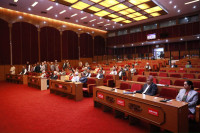Columns
Buddha love of Nepali theatre
There is no dearth of resources for theatre people who want to use Buddha themes for their works.
Abhi Subedi
he third Buddha Theatre Festival was organised in Kathmandu by Dabali Theatre at Rastriya Nachghar under the tutelage of this group's director and theatre person Puskar Gurung from March 27-30. One question that strikes me after attending this festival is why Nepali theatre people are interested in the Buddha. This generates other questions like what is the reason for selecting Buddha motifs for the dramaturgy that they have been practising, especially with more vigour since the turn of the century in Nepal. In this paper I have made some attempts to decode the meaning of Buddha theatre festivals. I have also put my personal experience acquired from close involvement in performances with Buddha themes.
The theatre people's modus operandi is different from that of others who organise Buddhist festivals at different times of the year. Lumbini, the birthplace of Gautama Buddha, and Kapilavastu dominate the parlance about the Buddha and his nativity. The first Buddhist conference organised in Nepal was held in November 1956. As history says, that was the fourth conference of what was called the “World Fellowship of Buddhists (WFB)". Nepal was chosen as the venue for being the land of the Buddha's birth to "mark the 2500th anniversary of the Mahaparinirvana of Lord Buddha". It was organised by Dharmodaya Sabha founded with the pious wish of Dr GP Malalasekara of Sri Lanka in 1950.
Amazing song
This important conference is not commonly mentioned in the Buddhist narratives of Nepal. But the song that poet singer Dharmaraj Thapa presented on the occasion still brings the fresh power and creative sway of Buddhism. Luckily, we can google and listen to this amazing song entitled Janmecha Buddha Nepalma (Ever a joy, the Buddha was born in Nepal) in his mellifluous voice. The song that he wrote himself is a great poetic work that so brilliantly brings the imageries of the Himalayan geography and the diverse lives of the people in this land, and creates a grand symphony of love, pride, compassion and sense of liberation. We as theatre people find a great power of performativity in this oeuvre of Dharmaraj Thapa.
That spirit is in the background of the theatre festivals that theatre people have been organising over the years. The above theatre festival this year addressed the same theme by evoking what was called the compassion of the Buddha, which they did by dramatising different moments of the Buddha's life stories. Some titles like Chandalika, Three laughing monks, Paschatap and Amrapali are enough to indicate the nature of the motifs that the theatre directors had chosen for performance. These are commonly familiar themes drawn from the Buddha's life. The classic work of poet Ashva-ghosha of the first century CE titled Life of the Buddha (2008) is one of them. Poet and philosopher Ashva-ghosha occupies a place of importance in this region before the Sanskrit poet and dramatist Kalidasa of the fifth century made his impact.
Buddha performances on the stage are based on stories drawn from various Buddhist texts. I consider one other work very interesting. It is a realistic and fictional account of the life and teachings of the Buddha entitled Old Path White Clouds (1991, 2022) written by a Vietnamese Zen master Thich Nhat Hanh. The moral of this discussion is that apart from the oeuvres mentioned here, there is no dearth of resources for theatre people who want to use Buddha themes for their works. But when we turned to the Buddha and his method and modes of what I would like to call the poetry of his life to use in our theatres, we had to develop our own methods and patterns for the performance. That has been an interesting but strong challenge. There is no space to discuss all that here.
I would draw some examples from the Buddha Theatre Festival, which according to its director Gurung, is an ongoing process, and an experiment in combining ideas with performance. The discussion about the choice of Buddha themes for performance found some expressions at a seminar on the last day of the festival. In the seminar organised by Dr Bal Bahadur Thapa for Dabali Theatre's cultural corporation and cogently moderated by Dr Sachin Ghimire, papers were presented to show both limitations and diversities of Buddha themes for performance. Dr Punya Parajuli, well-known Buddhist scholar and Tibetologist, described how the Nepali princess Bhrikuti now features in Tibetan drama. Her theme has become a subject of the politics of knowledge that can be discerned through performance and theatre.
It was a subject of great interest for me to see that several of those scholars who presented papers are teachers at the Central Department of English. The diversity of themes can be explained in terms of the interdisciplinary subjects that they incorporate in the department's curricula. Titles speak. Dr Shiva Rijal's topic was "Being in Samsara: A Buddhist reading of Hamlet’s soliloquies". Dr Taralal Shrestha chose to give a talk on "Bicycling of Buddha’s birth to death places for peace and planet". Dr. Bal Bahadur Thapa gave a talk on "Stretching the limits of the nationhood: A tale of a lonely Bauddha Bihar". Sanjaya Shakya, like last time, chose to give a talk on "The compassion of Buddha in Aśvaghoṣa's Buddhacarita". Umesh Regmi spoke on "The practice of compassion in Tiji: A Buddhist performance in Mustang". Kalpana Parajuli sought to find some links to the Nath perception of performativity.
The middle path
I presented my own experience about choosing Buddhist themes for writing plays. Giving examples from my own plays and their performance, I tried to show that the poetic dimension of Buddhism and the theme of compassion can be used to create Buddha texts and performances. In this experiment, you do not necessarily draw the major story from the Buddha's life but use the aesthetics and spirit of the Buddhist oeuvre. I give only one example here. When I wrote a play entitled Mayadevika Sapana (The Dreams of Mayadevi) for Nisha Pokhrel who needed it to perform in Indian cities, I worked with limited resources. They were the birth story of Gautama, the Maoist war, the narratives of an ex-Gorkha soldier in the Indian Army who had lost one arm and the mother of a guerrilla who had left home. I have named her Mayadevi, and by using a little surrealistic technique, I have presented the story of Gautama's birth. In theatre, the work of a stage creator is very important. Birendra Hamal's brilliant creation of what is called mise en scène or stage setting has helped Buddhist theatres including this one.
The reason for the Buddha love of the Nepali theatre people is guided by the thematic and performative power of the Buddhist aesthetics and pragmatisms of the middle path.




 20.12°C Kathmandu
20.12°C Kathmandu















